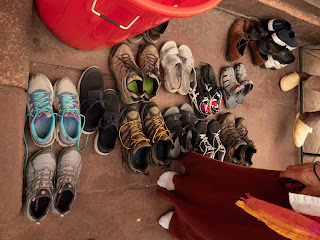Day 2: Delhi
Day 2: Delhi
Molly and Dave arrived early this morning (got to bed at 4am) and met us for breakfast at 9, wide-eyed and bushy-tailed. Breakfasts are going to be our downfall.
Driving through the city to our first destination, old Delhi’s market area, Chandni Chowk, we passed the iconic India Gate
and the Ministry of Defense.
Old Delhi is in stark contrast to the British designed New Delhi. The streets are narrow lanes filled with thousands of people, animals, shops, and garbage. The buildings and roads are in various states of disrepair. In other words, real India.
To experience this 1st hand, Hemesh ordered up 5 pedicabs for us. Our driver was about 5’4” and tipped the scales at about 100lb, but could have easily worn the yellow jersey at the Tour de France. No way we could have kept up with him even though he was moving 400lb of people and bike on terrible roads with rock hard tires (Jeri’s bruises could attest to that).
The Chandni Chowk (Moonlight Square) is one of the oldest and busiest markets in Old Delhi, India. It is located close to Old Delhi Railway Station.
We took the pedicab through the market dodging pedestrians, cars, oxcarts, and other pedicabs.The market was once divided by canals (now closed) to reflect moonlight and remains one of India's largest wholesale markets.
Located at the western end of Chandni Chowk, Khari Baoli is a street entirely dedicated to all kinds of spices, dried fruits, nuts, herbs, grains, lentils, pickles and preserves. We stopped in one of the nicer spice shops for a primer on Indian spices, teas and coffees. We left 30 minutes later with about $50 worth of tea and spices.
From here, we continued on by “auto rickshaw” (motor scooter pedicab which translates to faster and scarier) to India’s largest mosque, Jama Masjid, built in 1656 by Mughal ruler, Shaha Jehan. Mughal Empire that ruled from Delhi and Agra. The Mughal dynasty ruled Delhi for more than three centuries 1500-1800.In the Old City, the Mughals and the Turkic
rulers constructed several architecturally significant buildings, such as the Jama Masjid, and the Red Fort (which we saw from afar, but similar to the Red Fort in Agra which we will see in a couple of days.
Next stop was the Sikh Temple, Banglaw Sahib The Sikh’s major tenet is to help others without proselytizing, and the temple here has a kitchen which serves 10,000 meals a day! Anyone can eat here, including daring tourists (not us). It is manned completely by volunteers from the Sikh community (Sikhs are required to donate time, money, or food). In order to enter the temple and the kitchen, everyone is required to remove shoes AND socks. We were all pretty grossed out (did some significant foot sanitizing at the conclusion).
This evening, we dined at one of India’s top 5 restaurants, Bukhara, which happened to be in the hotel that Trump was at last week. We had the waiter order for us, and had a remarkable dinner. All our friends kindly toasted Brendan and Jessica’s engagement, making it even more special.




















































No comments:
Post a Comment